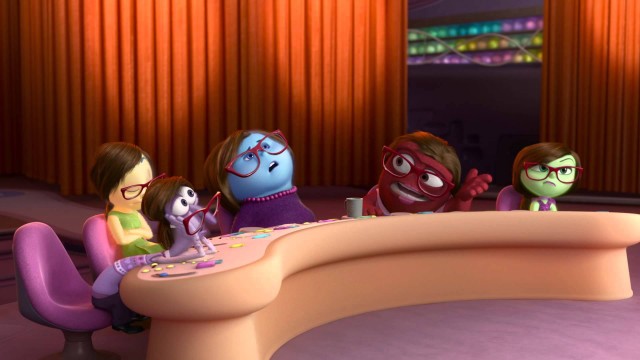I am pleased to announce that my son has moved on from watching The Many Adventures of Winnie the Pooh twice a day. Now, “the movie” is Inside Out. It’s actually the first movie he’s ever sat through from beginning to end without getting distracted and wandering off. I’m okay with the whole thing, honestly, because the movie still holds up. Even this many viewings along.
Actually, the more times I see it, the more things I notice that I hadn’t when I saw it the first time. There are also a lot of things I didn’t consider the first time, or the second, or the fifth, that I’ve considered now simply because I’m putting more thought into it. I’ve got to keep myself occupied somehow, and honestly, I’m happier thinking about Joy and Sadness and the other characters than I am thinking about how horribly Rabbit is mistreated by the other denizens of the Hundred-Acre Wood. Or wondering why anyone thought there needed to be a sequel about New Year’s Eve or Easter.
Some of it is little things. The cards, for example. We see the mind workers building a house of cards twice in the story, and the cards have Riley’s parents as the king and queen, and instead of a Jack, there is a card labeled “R” with Riley’s picture. Similarly, if you look in the backgrounds of various scenes where Riley is in school, Jordan—the boy from the end, and from the short “Riley’s First Date?”—is there. He’s in her class, and he’s in the school yard when she’s having lunch alone.
On the other hand, I’ve developed a theory about Bing Bong that I’m going to share and that is full of spoiler, so beware. Bing Bong is the only “escapee” from Imagination Land that we know of who is wandering loose in Riley’s mind. Imaginary boyfriends? Maybe, but maybe not. As I said, if they do, we don’t see them, and they certainly don’t have the same level of personality that Bing Bong does.
That, I think, is because Bing Bong was real to Riley in a way that the imaginary boyfriends, and the citizens of Cloud Town, and so forth, are not. When she was very small, she spent a lot of her time playing with him. She will still have memories of that time, even though many of them will doubtless have faded. (The one aspect of the movie that I think is too simplistic is the idea that faded memories go away completely, but I’m willing to accept that for dramatic purposes.) We don’t know how long it’s been since Riley played with Bing Bong, but she’s eleven, so it’s clearly been a long time. When Bing Bong fades, what fades is not all her memories of him but her ability to believe in him.
In fact, while one of the last jokes in the movie is the Big Red Puberty Button, what happens to Riley during the time when she cannot access Joy and Sadness is that she starts the process of growing up. The idea that her identity was formed in Minnesota and that she should therefore go back to Minnesota to be happy again, even if it means running away, is frankly a childish idea. That’s okay; Riley is eleven, and she’s allowed to have childish ideas. She is even allowed to act on them, but when she harnesses her “negative” emotions—and remember, the climax relies on both Sadness and Anger to get Joy in charge again—she is able to face things instead of running away.
The movie, in the long run, shows all five emotions as having both positive and negative aspects. At the beginning, of course, Joy sees herself as nothing but positive and conversely can see no positive aspect to Sadness. She does, however, have positive things to say about the other three. Fear keeps Riley safe. Disgust keeps Riley from being poisoned, which is another way of keeping her safe. Anger cares very deeply about things being fair. But Fear prevents Riley from exploring, and Disgust does as well in a different way. Anger lashes out at people. But Joy cannot empathize. That’s Sadness’s job.
Not everyone is run by their Joy, though Riley’s teacher is. (You might also notice that, on the white board, there’s a box with “compliments” written in it and about eight or ten hash marks; clearly, she’s taking notice of when the students compliment things and praising them for it.) Riley’s parents, noticeably, are run by his Anger and her Sadness. However, we do for the most part see them as balanced individuals. They’re in a stressful position—they’ve just moved across the country. It’s clear there are problems with the start-up they’ve moved there for. Their daughter is not being her normal cheerful self. However, her father doesn’t shout at everyone all the time. Her mother doesn’t burst into tears and obsess over the weight of life’s problems. They’re doing pretty well, all things considered.
I would also like to point out, and I noticed this about the fourth time through, that Riley’s parents’ emotions look like hers. Her father’s Joy and Disgust in particular look like Riley’s Joy and Disgust, only with moustaches. Sure, the moustaches mean that they present as male, and they’re wearing the suit that all the other emotions wear in his head. It does, though, seem clear from the bits in the credits that people’s emotions grow and change; all the clown’s emotions are wearing clown makeup, remember. You figure that probably wasn’t true when he was eleven.

